War is not a woman's face?
Ancient Greek authors wrote about them as about fearless female warriors of the Savromat tribes who roamed the Northern Black Sea region and nearby lands. In the twentieth century, reports of ancient historians and travelers were confirmed by numerous archaeological excavations. But not so much with regard to the Savromats, as with respect to the Scythians. Although the ancient authors did not write about Scythian female warriors. Indeed, among the female burials discovered by Soviet, and then Russian and Ukrainian archaeologists, a considerable part was made up of burials in which weapons were present. What can I say - and the author of these lines in 2001 was fortunate enough to participate in an archaeological expedition, during which the burial of a warrior woman was excavated in the city of Taganrog. “Fire-Baba” in life was definitely not lower than 180, see growth, and in addition to the gold earrings, the sword was also present in the burial - evidence of her belonging to the soldiers.
As a rule, women from higher strata of Scythian tribes became female warriors. Most of them died on the battlefield or died from wounds at a young age - in 20-25 years. But there are also burials of more mature ladies with weapons. Say, forty-year-old female warriors were also not uncommon. For the dead or deceased female warriors, funeral rites were held similar to the funerals of male soldiers. That is, in fact, they enjoyed equal rights. On the other hand, there were practically no women warriors in the lowest part of the Scythian society - the poor Scythian women were engaged in housekeeping.
The adoption of Christianity and Islam as the dominant religions in the Eurasian region significantly reduced the possibility of women entering the military service. In the Abrahamic religions, a woman was never considered a warrior, although story The Middle Ages and the New Times both in Christian Europe and in Muslim Asia know many examples of the participation of individual women in wars and uprisings. In Russia, the possibility of entering the military service for women opened Peter the Great. In the adopted by this emperor - reformer, the military charter of 1716 ordered women to serve in military hospitals, as well as the use of female labor in the economic support of the army. During the reign of Empress Catherine II, a special female company operated in the Crimea, where officers officers and daughters were recruited. Women learned the techniques of cavalry attack, engaged in fire training. But the company did not exist for long and was soon disbanded - despite the fact that the woman was on the throne of the Russian Empire, the stereotype about the unsuitability of women for military service was too deeply rooted in the minds of both the military commanders and the nearest courtiers.
Recall the "cavalryman-girl"
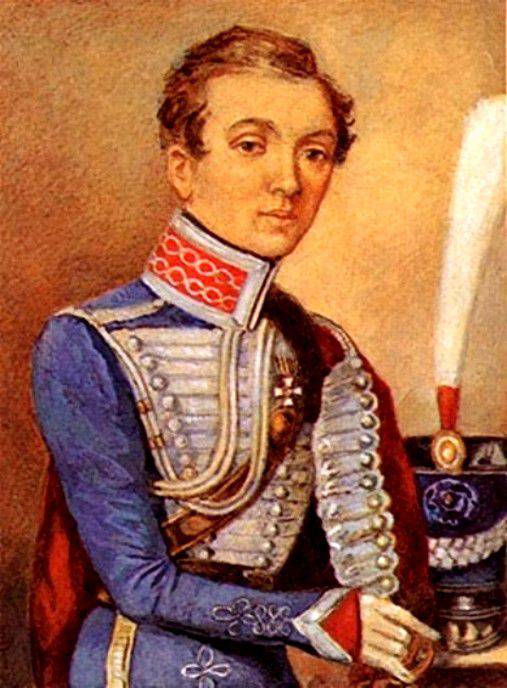 However, the Patriotic War 1812 of the year again forced women to stand up for their native country, along with their husbands, fathers and brothers. Perhaps the most famous example of the legendary "cavalry girl" sung in Russian literature. Nadezhda Andreyevna Durova (1783-1866) became the first female officer of the Russian imperial army. Moreover, her military career began before World War 1812. Eighteen years old, the daughter of the hussar captain Nadia Durova was married, but having given birth to a son, she could not become an exemplary wife and mother, leaving her former spouse and child. Then Durova fell in love with the Cossack есsaula and fled with him to the Cossack regiment, where the beloved served. It was Durova, then twenty-three years old, and living together with the captain, she pretended to be his orderly — the young man. Later, after parting with the captain, Durova went to the Konnopolsky Ulan regiment. There was no need to wear beards, unlike the Cossack regiment, so Hope was not afraid to be exposed - she simply presented herself as an 14 youth for years and was enlisted in the regiment as a private. For her bravery, she received the Cross of St. George and was promoted to non-commissioned officer. Naturally, the true sex of Durova remained secret. However, shortly before the signing of the Peace of Tilsit, the father still managed to find his daughter. The command of the regiment detained the "cavalry-girl" and sent to St. Petersburg. There, Durov was personally received by Emperor Alexander I, who was struck by her courage and allowed the woman to continue her military service as an officer, under the name of Alexander Andreyevich Alexandrov.
However, the Patriotic War 1812 of the year again forced women to stand up for their native country, along with their husbands, fathers and brothers. Perhaps the most famous example of the legendary "cavalry girl" sung in Russian literature. Nadezhda Andreyevna Durova (1783-1866) became the first female officer of the Russian imperial army. Moreover, her military career began before World War 1812. Eighteen years old, the daughter of the hussar captain Nadia Durova was married, but having given birth to a son, she could not become an exemplary wife and mother, leaving her former spouse and child. Then Durova fell in love with the Cossack есsaula and fled with him to the Cossack regiment, where the beloved served. It was Durova, then twenty-three years old, and living together with the captain, she pretended to be his orderly — the young man. Later, after parting with the captain, Durova went to the Konnopolsky Ulan regiment. There was no need to wear beards, unlike the Cossack regiment, so Hope was not afraid to be exposed - she simply presented herself as an 14 youth for years and was enlisted in the regiment as a private. For her bravery, she received the Cross of St. George and was promoted to non-commissioned officer. Naturally, the true sex of Durova remained secret. However, shortly before the signing of the Peace of Tilsit, the father still managed to find his daughter. The command of the regiment detained the "cavalry-girl" and sent to St. Petersburg. There, Durov was personally received by Emperor Alexander I, who was struck by her courage and allowed the woman to continue her military service as an officer, under the name of Alexander Andreyevich Alexandrov. It was under this name that Durova was enlisted in the Mariupol hussar regiment with the rank of second lieutenant. However, soon from the hussar regiment Durov transferred back to the lancers. She served in the Lithuanian Ulan regiment, during World War II commanded a half-squadron, took part in the Battle of Borodino. After receiving the rank of lieutenant, she served as an orderly under Mikhail Illarionovich Kutuzov, who was aware of the true story of the bezusogo lieutenant. In 1813, the city of Durova participated in the German campaign, stormed Hamburg, and only in 1816 did she retire as a staff captain. Durova continued her long life in Sarapul and Elabuga and died fifty years after she retired from military service.
However, the example of the “cavalry girl-maiden” precisely for this reason became so famous and was sung in Russian literature that it was an exception to the general rules. Of course, Durova was an unusual woman and most likely her behavior had psychological reasons. After all, even after she retired, Nadezhda Durova wore a man's dress and demanded to turn to herself as a man.
Sisters of mercy and compassionate widows
The mass participation of women in hostilities as employees of auxiliary units and services of the army began in the Crimean War. Initially, women were used in the medical service - as sisters of mercy. In November, 1854 was sent to Crimea by 120 sisters of mercy from the Holy Cross community of the nurses' care for the sick and wounded soldiers of Russia. This community included women from all walks of Russian society, from simple peasant women and petty bourgeois to wives, daughters and widows of the highest aristocracy. Alexandra Petrovna Stakhovich, the captain's widow, became the first superior sister of the community. However, Ekaterina Aleksandrovna Khitrovo changed her soon. However, a few months later Khitrovo died of typhus and Ekaterina Mikhailovna Bakunina became the head of the sisters community.
The overall coordination of the activities of sisters of mercy in the Crimea was carried out by the famous doctor, full state councilor Nikolai Ivanovich Pirogov. By the beginning of 1856, the total number of sisters of mercy from the Holy Cross community working in hospitals of the Russian army reached more than 200 people. The doctor Pirogov emphasized that the sisters of mercy "alternately day and night in the hospitals, help with the dressing, sometimes with the operations, hand out tea and wine to the sick and watch the attendants and caretakers and even the doctors. The presence of a woman, neatly dressed and assisted, enlivens the deplorable vale of suffering and distress. ”
Most of the sisters of mercy worked in Sevastopol and Simferopol, but small groups of sisters were in the hospitals of Bakhchisarai, Nikolaev, and Kherson. Despite the fact that the sisters did not participate in hostilities, they also suffered losses. During the military campaign, the 17 sisters of the Holy Cross community died. Most of the losses in the ranks of voluntary medical assistants came from the effects of typhus epidemics.
From 13 on January 1855, a squad of 12 sisters of mercy was in Sevastopol, working at the main dressing station and in a temporary hospital. The sisters of mercy carried daily duty and assisted doctors in operations and dressings. Although almost all the sisters of mercy did not have any special medical knowledge before arriving in Crimea, they coped with their duties better and better over time, which gave the doctor Pirogov, who controlled their activities, to speak about the contribution of sisters of mercy to the military medical service of the current army with great respect. By the way, the sisters of mercy at that time carried out not only sanitary and medical functions, but also performed tasks, as they would say now, the social protection of wounded and sick soldiers. They represented their interests, watched the activities of hospital staff and even hospital management, including revealing abuses by hospital managers.
In addition to the sisters of mercy, another group of women, compassionate widows, also took part in the medical support of the Crimean War. In November, 1854 57 compassionate widows arrived in Simferopol, which were later joined by 25 local residents, who also took initiation into this community. Like the sisters of mercy, compassionate widows bothered to kind words from Nikolai Ivanovich Pirogov. The legendary doctor noted that “compassionate widows arrived ... in Simferopol at the most difficult and critical time. The hospitals, which were still barely organized in various institutions and private houses in the city, were filled with sick and wounded people; unremitting transportation of patients ... prevented their sorting; constantly wet weather made drying and changing linen much more difficult; lacked neither hands, nor premises, nor dressing facilities; wounds began to take on a bad quality; contagious typhus seemed. The sisters of the Holy Cross community, who arrived a few weeks before the compassionate, began to care for the sick with great activity, could not resist and were sick of exhaustion and hospital infection, so compassionate found hospitals without female workers. ”
In fact, it is the compassionate widows that should be considered the first example of the organized use of women for medical care. Their story began in 1814, after widow houses were opened in Moscow and St. Petersburg. The initiator of their creation was Maria Feodorovna - the spouse of the late Emperor Paul by that time. Maria Feodorovna believed that widow houses should be Christian communities with strict discipline, functioning on the model of Orthodox monasteries. At the same time, Maria Feodorovna did not see widows only as the poorhouse’s clients - she believed that they could and should be attracted to help in medical institutions, since women would be more gentle and caring to treat patients than men - doctors and paramedics. From the beginning of 1814, the first 24 widows went to the Mariinsky hospital for duty. This is how the congregation of compassionate widows arose, over the course of a century which made a great contribution to helping the sick, and in the war years to the wounded subjects of the Russian Empire. During the Crimean campaign, 12 compassionate widows died from illness and deprivation.
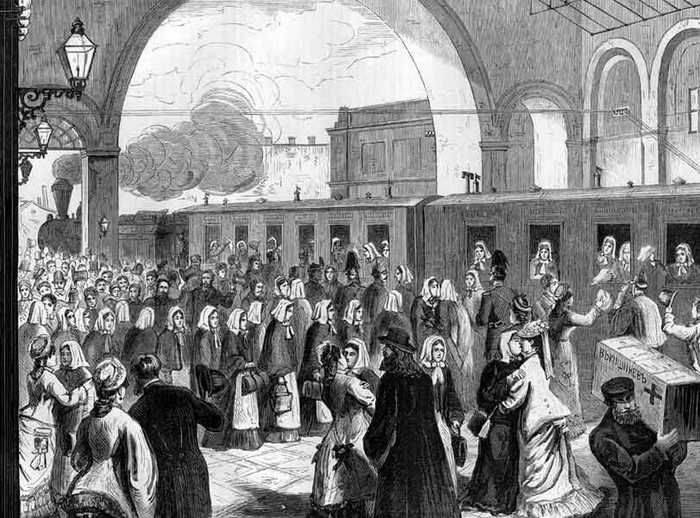
In 1876, Serbia and Montenegro declared war on Ottoman Turkey. Hundreds of Russian volunteers rushed to the aid of the Slav brothers. Among them were not only military officers, but also sisters of mercy, who were in a hurry to fulfill their usual duty to help wounded and sick soldiers. A detachment of the community “Quench my sorrows” under the leadership of NB arrived in Serbia. Shakhovskoy. At first it numbered 39 people, then the number of sisters of mercy grew to 118 people. Thanks to the activities of Shakhovskaya and her assistants, several hospitals were organized in Serbia, each of which received up to 500-600 wounded a day.
After 12 on April 1877 of Alexander II signed a manifesto declaring war on the Ottoman Empire, hundreds of sisters of mercy rushed into the Russian army. As during the Crimean War, among them were women of different social status and different ages. Naturally, all the women entering into the sisters of mercy were moved by different motives. Someone was guided by a sincere desire to help the wounded and sick, someone followed religious beliefs, someone more acted, guided by the desire to assert themselves. The latter category was quite numerous and this could not but cause discontent on the part of other sincere sisters, and military priests, and the command. By the way, many sisters of mercy came from social lower classes or ruined families, and participation in the military campaign became normal work for them, allowing them to make ends meet. In any case, regardless of the motivation, the overwhelming majority of the sisters of mercy courageously and conscientiously did their work, saving thousands of wounded and maintaining an elementary order in the location of the hospitals.
Even before the start of hostilities, a system of training for sisters of mercy was created and streamlined. The experience of the Crimean War showed that there is nothing to do in a hospital without medical knowledge. In February, the Medical Community in St. Petersburg launched the first medical training course for nurses, which gathered 1877 students. The overwhelming majority of those who studied were Russian Orthodox women, but they learned the basics of nursing and the Catholic (500 people), and Lutheran (6 people), and Jews (12 people). Following Petersburg, the training of nurses began on similar courses in several cities of the Russian Empire - in Tambov, Poltava, Chernihiv, Kursk, Saratov, Kostroma, etc.
While the main contingent of sisters of mercy was being prepared in Russia, the veterans of the sister communities were already present at the fronts of the Russian-Turkish war. First of all, these were the sisters of the St. George community - 27 women headed by E.P. Kartseva, the last Crimean War, the sisters of Holy Cross community - 32 women headed by Nadezhdina and Shchekhovskaya. By the time the war began, Elizaveta Petrovna Kartseva, who headed the sisters of St. George’s community, was already an elderly woman, but also went to field hospitals along with younger fellow women. Nikolai Vasilievich Sklifosovsky, who took part in the Russian-Turkish war as a military doctor, was opposed to the use of women in the service of military hospitals, but he could not help but admire the highest workability and dedication of the sisters of mercy. Moreover, in the days of the war, women - doctors and nurses had to go under enemy fire. As Sklifosovsky recalled later, “these women brought a lot of benefit at the main dressing station. And despite the fact that they had to endure the most difficult trials on the memorable 30 day of August 1877, they endured all the hardships with courage and worked to the end. Perhaps that was the only example of the activities of the sisters of mercy under enemy shots. ”
However, a short time will pass - and a nurse, not only caring for the sick in the hospital, but also pulling out wounded soldiers and officers from the battlefield, will become a familiar participant in the hostilities. Moreover, the end of XIX-early XX centuries. It was a milestone in the issue of the emancipation of women. More and more women received higher education, sought to bring benefits not only in family life, but also in public service.
In the trenches of the First World War
The beginning of the First World War, accompanied by a patriotic upsurge in the country, entailed the recording of hundreds and thousands of women as sisters of mercy. Women took care of the wounded and sick soldiers and officers, and in the rear - in hospitals and on the front lines. An example for many women was given by the Empress Alexandra Fedorovna herself and her daughter Olga and Tatyana. They completed the Red Cross courses and helped in hospitals.
Many sisters of mercy were on the front line. Trying to take the wounded from the line of fire, the sisters of mercy were subjected to shelling. At the same time, they demonstrated courage worthy of soldiers and officers of the army in the field. So, sister E.A. Girenkova was awarded the Order of St. George 4 degree. This award was a testament to her courage, manifested during more than two months on the front line, where her sister saved the lives of many Russian soldiers. At the same time, unlike the German sisters of mercy, which were characterized by cruel treatment of Russian prisoners and even participation in the killings of Russian wounded, our sisters of mercy demonstrated a humane attitude towards the enemy. Wounded Germans and Austrians were treated in Russian military hospitals, and the same sisters of mercy looked after them no less carefully and conscientiously than Russian soldiers.
The Order of St. George 4 degree was posthumously received by the sister of mercy Rimma Mikhailovna Ivanova. This brave woman, who had taught children before the war, voluntarily went to the front and served in the 105-th Orenburg Infantry Regiment. 9 September 1915 in the next battle killed the commander of the 1 company and company officers, after which the sister of mercy rushed to the attack at the head of the company soldiers. The enemy trench was captured, but twenty-year-old Rimma Ivanova received a mortal wound. She was buried in her homeland, in Stavropol.
It was during the First World War that the practice of admitting women for military service to military units began. If before the use of women was reduced to their participation in the medical and economic support of the troops, during the First World War there were women — telephonists and even combat officers. Maria Isakova, engaged in horse riding and fencing before the war, appealed to the commander of the Cossack regiment with a request to enlist her in the personnel of the regiment. Of course, the commander refused. Then the brave athlete at her own expense bought uniforms and weapons and set off to catch up with the regiment. In the end, the commander went to meet Isakova and enlisted her in the regiment's horse reconnaissance.
During the Civil War years, dashing chieftain Marusya Nikiforova, by the time World War I began, was in emigration to France, but managed to finish a military school there and in 1917 to take part in hostilities in Macedonia, where the French corps fought.
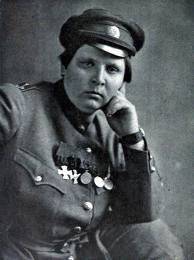 Since 1914, by the highest permission of Emperor Nicholas II, Maria Bochkareva was in the army - perhaps the most famous Russian woman who participated in the First World War. By the time of the beginning of World War I, Maria Leontyevna Bochkareva was already 25 years old. She was the third daughter of the peasants of the village of Nikolskoye, Kirillovsky district of the Novgorod gubernia, Leonty Semenovich and Olga Elekarovna Frolkovy. In 15 years, Maria married 23-year-old Athanasius Bochkarev. However, Maria's family life did not work out. Husband drank deeply. After leaving him, Maria confronted the butcher Jacob Bouck. However, he was soon arrested for robberies and robberies and sent into exile in Yakutia. There Buk joined the local robbers and was transferred to a settlement in the taiga village. Mary went there too. However, in the end, drunkenness and the lifestyle of her husband forced her to ask to join the army. She sent a telegram to the emperor, and he allowed her to go to the front with the highest permission. There, Maria Bochkareva showed herself in the highest degree worthy, received three medals and the Cross of St. George, rose to the rank of senior non-commissioned officer.
Since 1914, by the highest permission of Emperor Nicholas II, Maria Bochkareva was in the army - perhaps the most famous Russian woman who participated in the First World War. By the time of the beginning of World War I, Maria Leontyevna Bochkareva was already 25 years old. She was the third daughter of the peasants of the village of Nikolskoye, Kirillovsky district of the Novgorod gubernia, Leonty Semenovich and Olga Elekarovna Frolkovy. In 15 years, Maria married 23-year-old Athanasius Bochkarev. However, Maria's family life did not work out. Husband drank deeply. After leaving him, Maria confronted the butcher Jacob Bouck. However, he was soon arrested for robberies and robberies and sent into exile in Yakutia. There Buk joined the local robbers and was transferred to a settlement in the taiga village. Mary went there too. However, in the end, drunkenness and the lifestyle of her husband forced her to ask to join the army. She sent a telegram to the emperor, and he allowed her to go to the front with the highest permission. There, Maria Bochkareva showed herself in the highest degree worthy, received three medals and the Cross of St. George, rose to the rank of senior non-commissioned officer. It is not surprising that it was Maria Bochkareva who came to power as a result of the February 1917 revolution. The Provisional Government made it a symbol of women's participation in the war. Maria became one of the initiators of the formation of the “women's death battalions”, who were primarily faced with agitation and propaganda tasks. Women warriors were to show soldiers and officers examples of personal valor and courage. 27 June 1917 The women's battalion numbering 200 was transferred to the rear of the 1 Siberian Army Corps of the 10 Army of the Western Front, under Smorgon. The battalion was attached to the 525 th Kyuryuk-Darya Infantry Regiment of the 132 Infantry Division. July 8 battalion joined the battle, reflecting within three days, fourteen German attacks, as well as taking counter. From 170, a man in the women's battalion killed an 30 man and injured 70. Injury — the fifth in her life — was also received by Maria Bochkareva, who was made a second lieutenant.
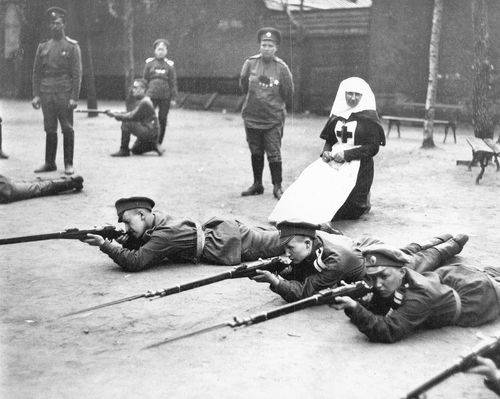
The heavy losses of the women's battalion forced 14 August 1917 of the new commander-in-chief, General Lavr Kornilov, to prohibit the use of units equipped by women on the front line. Women's units were instructed to perform sanitary, security functions in the rear and provide communication. 1-th Petrograd battalion, commanded by staff captain A.V. Loskov, in October 1917, participated in the defense of the Winter Palace, remaining one of the last metropolitan military units that remained loyal to the Provisional Government. 30 November 1917 The women's battalions were disbanded. Many women serving in them subsequently took part in the Civil War. In the Kuban 4-th Women's Shock Battalion operated, which existed until February 26 1918.
The heroic path of the Civil and Great Patriotic
Women also served in the Red Army. Perhaps their use in the Red Army and KGB units became even more widespread than in the imperial army during the First World War. Many girls and women were in political work in the Red Army. Among them were professional revolutionaries with pre-revolutionary experience, and women and girls who joined the party during the Civil War. The most famous woman - the commissar of the Civil was Larisa Mikhailovna Reisner, brought by a distant relative to the descendants of Mikhail Illarionovich Kutuzov. Despite the aristocratic origin, she joined the revolutionary movement and during the Civil years was the commissar of Volzhskaya flotilla. The “Power of the Soviets” armored train was commanded by Lyudmila Mokievskaya, also an aristocrat, a graduate of the Smolny Institute of Noble Maidens. Her life journey ended in battle, during the operation to capture the enemy headquarters. In the 1st partisan special purpose detachment, commanded by the legendary Kamo (S. A. Petrosyan), Anna Novikova, “Anka - the machine gunner”, commanded the machine-gun platoon.
Evgenia Mikhailovna Shakhovskaya, one of the first women aviators, was born in a merchant family and married Prince Shakhovsky in his youth. Back in 1911, she received a pilot’s diploma, having graduated from the corresponding school in Germany. After graduating from a flight school, Shakhovskaya worked for some time as an instructor at an airfield - in the same place in Germany, and in 1913 she left Aviation. This decision was made after pilot Vsevolod Abramovich died as a result of a plane crash. Was in his death and the fault of Shakhovskaya. Considering it impossible for herself to continue to fly, Evgenia Shakhovskaya did not think that in a year she would have to take off again. When the First World War began, Shakhovskaya petitioned Emperor Nicholas II to be sent to the front. In November 1914, Shakhovskaya became a pilot of the Koven aviation detachment. But already in December of that year, Shakhovskaya was removed from the flights and accused of espionage. Perhaps - the whole thing was that behind the pilot there was training at a German aviation school and service at a German airfield. Shakhovskaya was arrested and sentenced to death, but the emperor replaced the execution with life imprisonment in a convent. After the revolution, the princess worked for some time in the museum, from where she was fired for embezzlement. During the Civil War, she entered the service of the Kiev Provincial Extraordinary Commission. Shakhovskaya became famous as one of the most brutal Cheka investigators, but her counterintelligence career was interrupted by her death under dubious circumstances - Shakhovskaya was shot dead during a drunken quarrel.
Women also fought in the ranks of the “third force” - numerous peasant armies, who preferred to fight against the whites and against the red ones. The above-mentioned Marusya Nikiforova commanded her own anarchist detachment and received notoriety for the numerous manifestations of cruelty and criminal tendencies. It is known that even her comrades in the anarchist movement, including Nestor Makhno, criticized her for these antics. By the way, the wife of the latter, Galina Kuzmenko, who gave birth to the “father Ataman” daughter Elena, also served in the Makhnovist army — in the cultural propaganda department.
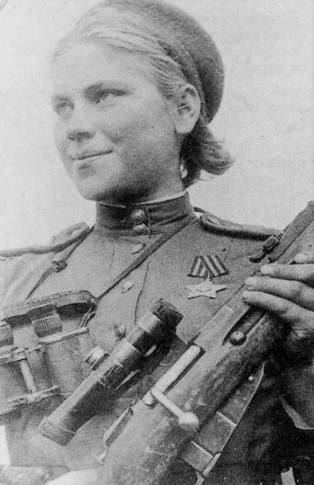 A large number of books and articles, both scientific and journalistic, have been written about the service of women in the ranks of the Red Army during the Great Patriotic War. Hundreds of thousands of women served in the active army - in the signal troops, aviation and tank units, air defense, military intelligence. Only in the 10th Air Army of the Far Eastern Front 3000 women and girls served, in the 4th Air Army of the 2nd Belorussian Front - 4376 women and girls. It is difficult to find a person who would never have heard of the legendary "Night Witches", about the exploits of Soviet nurses, orderlies, signalmen. Over the years of the existence of the Soviet state, 95 women were awarded the high title of Hero of the Soviet Union. Most of them received awards for their exploits during the Great Patriotic War. Mostly these are pilots and medical workers, members of underground organizations. By the way, women also played an important role in the partisan movement and underground organizations in the territory occupied by the Germans.
A large number of books and articles, both scientific and journalistic, have been written about the service of women in the ranks of the Red Army during the Great Patriotic War. Hundreds of thousands of women served in the active army - in the signal troops, aviation and tank units, air defense, military intelligence. Only in the 10th Air Army of the Far Eastern Front 3000 women and girls served, in the 4th Air Army of the 2nd Belorussian Front - 4376 women and girls. It is difficult to find a person who would never have heard of the legendary "Night Witches", about the exploits of Soviet nurses, orderlies, signalmen. Over the years of the existence of the Soviet state, 95 women were awarded the high title of Hero of the Soviet Union. Most of them received awards for their exploits during the Great Patriotic War. Mostly these are pilots and medical workers, members of underground organizations. By the way, women also played an important role in the partisan movement and underground organizations in the territory occupied by the Germans. Today, seven decades after the end of the Great Patriotic War, many thousands of women continue to serve in the ranks of the Armed Forces of the Russian Federation, in power structures. Sometimes they risk their lives every day and every hour. There are real heroines in the ranks of Donetsk and Lugansk patriots fighting in Novorossia.
When the war came to the peaceful land of Donbass, which in the years of the Great Patriotic War was watered with the blood of thousands of Soviet citizens, many women joined the militia. They, like their grandmothers and great-grandmothers, serve in medical units, communicate, perform intelligence tasks. There are those whose service is less noticeable, but this is no less important - they help Novorossia for hundreds or even thousands of kilometers from the Donbass. They collect humanitarian aid, place refugees, and provide informational support for military operations. All of them perform serious and sometimes dangerous tasks, but this does not cease to be women. Mothers, wives, brides, lovers, daughters, sisters and just friends. With the holiday of the eighth of March you, dear ones, and a peaceful sky above your head. Sincerely.
Photo of women of the militia of Novorossia - http://soratnik-81.livejournal.com/1933933.html
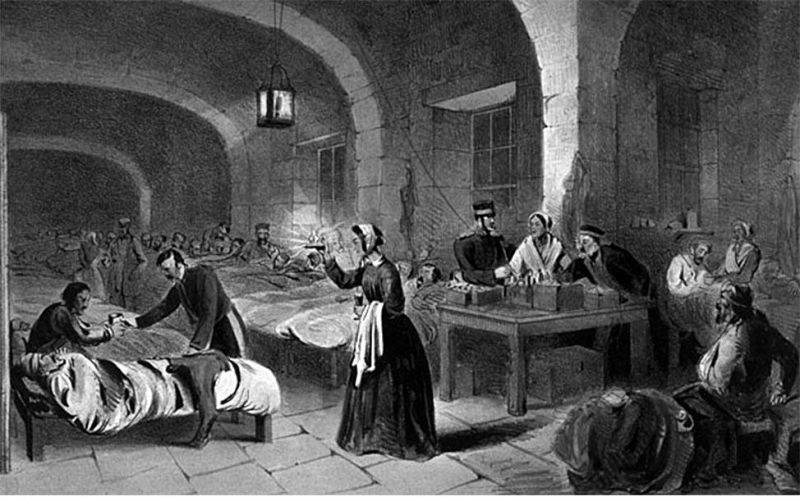
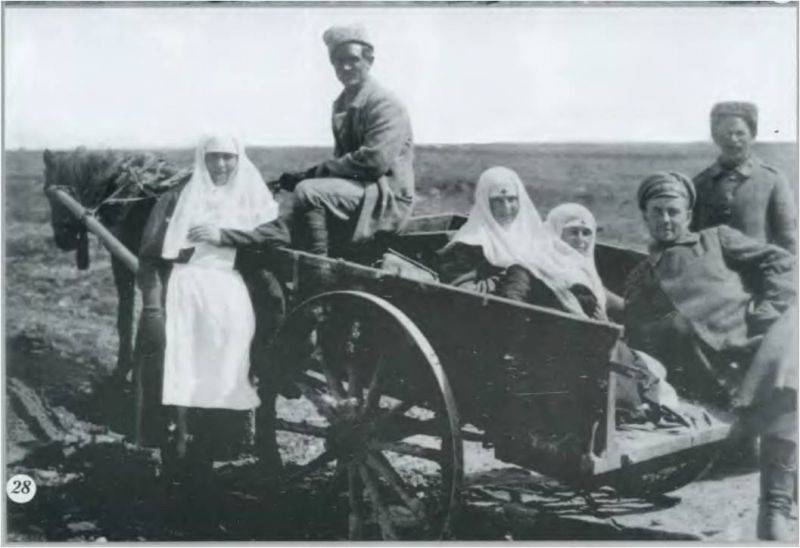
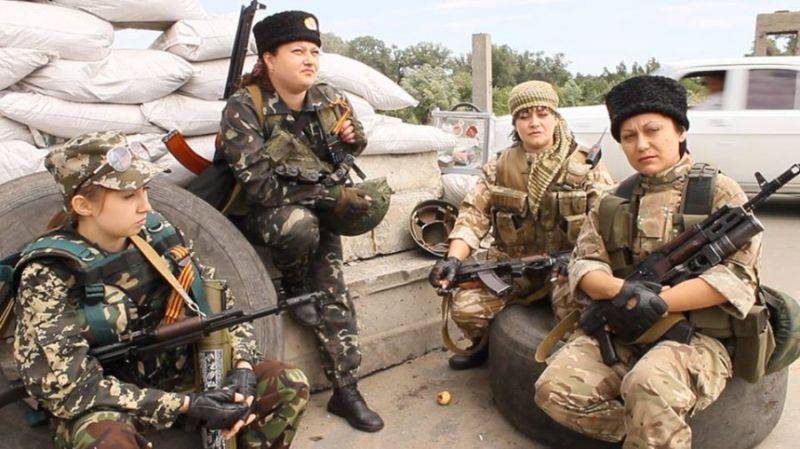
Information